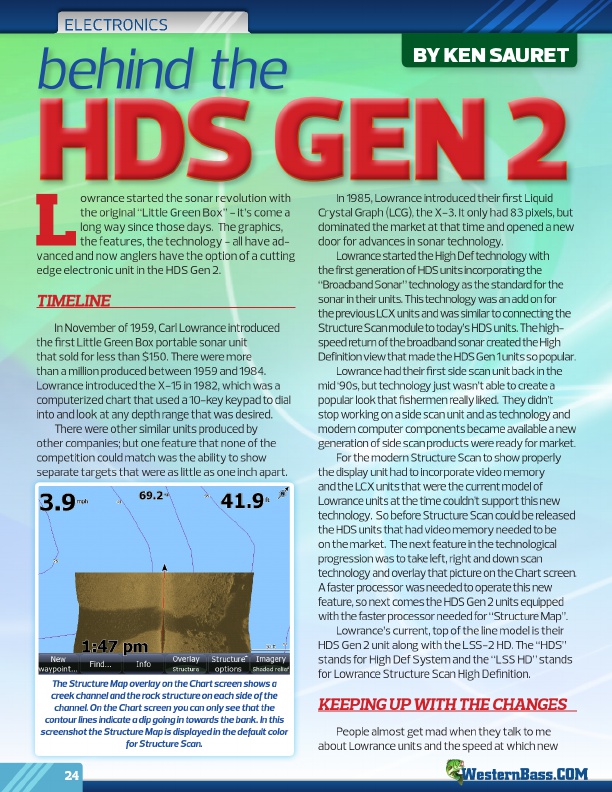
HDS Gen 2
behind the
eleCtroniCS
By Ken sauret
L
owrance started the sonar revolution with the original “little Green Box” - it’s come a long way since those days. The graphics, the features, the technology - all have ad- vanced and now anglers have the option of a cutting edge electronic unit in the HdS Gen 2.
TIMELINE
in november of 1959, Carl lowrance introduced the first little Green Box portable sonar unit that sold for less than $150. There were more than a million produced between 1959 and 1984. lowrance introduced the X-15 in 1982, which was a computerized chart that used a 10-key keypad to dial into and look at any depth range that was desired. There were other similar units produced by other companies; but one feature that none of the competition could match was the ability to show separate targets that were as little as one inch apart.
The Structure Map overlay on the Chart screen shows a creek channel and the rock structure on each side of the channel. On the Chart screen you can only see that the contour lines indicate a dip going in towards the bank. In this screenshot the Structure Map is displayed in the default color for Structure Scan.
in 1985, lowrance introduced their first liquid Crystal Graph (lCG), the X-3. it only had 83 pixels, but dominated the market at that time and opened a new door for advances in sonar technology. lowrance started the High def technology with the first generation of HdS units incorporating the “Broadband Sonar” technology as the standard for the sonar in their units. this technology was an add on for the previous lCX units and was similar to connecting the Structure Scan module to today’s HdS units. the high- speed return of the broadband sonar created the High definition view that made the HdS Gen 1 units so popular. lowrance had their first side scan unit back in the mid ‘90s, but technology just wasn’t able to create a popular look that fishermen really liked. They didn’t stop working on a side scan unit and as technology and modern computer components became available a new generation of side scan products were ready for market. For the modern Structure Scan to show properly the display unit had to incorporate video memory and the lCX units that were the current model of lowrance units at the time couldn’t support this new technology. So before Structure Scan could be released the HdS units that had video memory needed to be on the market. The next feature in the technological progression was to take left, right and down scan technology and overlay that picture on the Chart screen. a faster processor was needed to operate this new feature, so next comes the HdS Gen 2 units equipped with the faster processor needed for “Structure Map”. lowrance’s current, top of the line model is their HdS Gen 2 unit along with the lSS-2 Hd. The “HdS” stands for High def System and the “lSS Hd” stands for lowrance Structure Scan High definition.
KEEPING UP wITH THE CHANGES
People almost get mad when they talk to me about lowrance units and the speed at which new
24